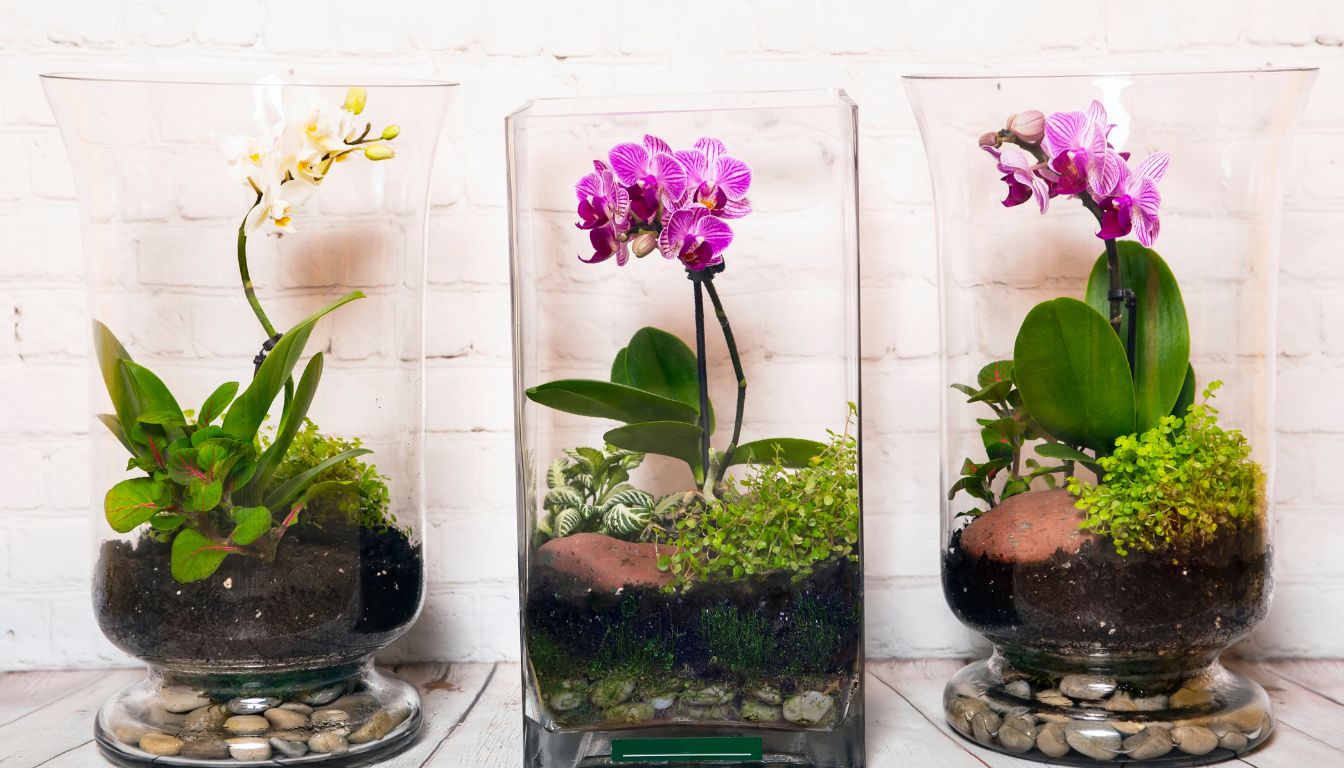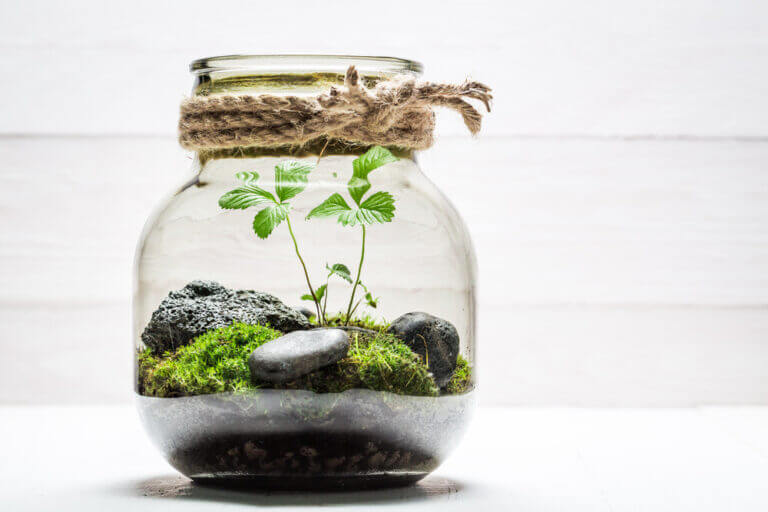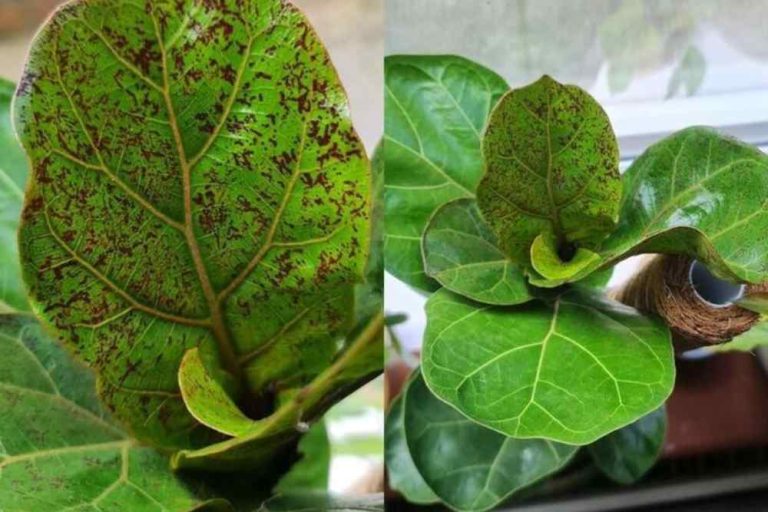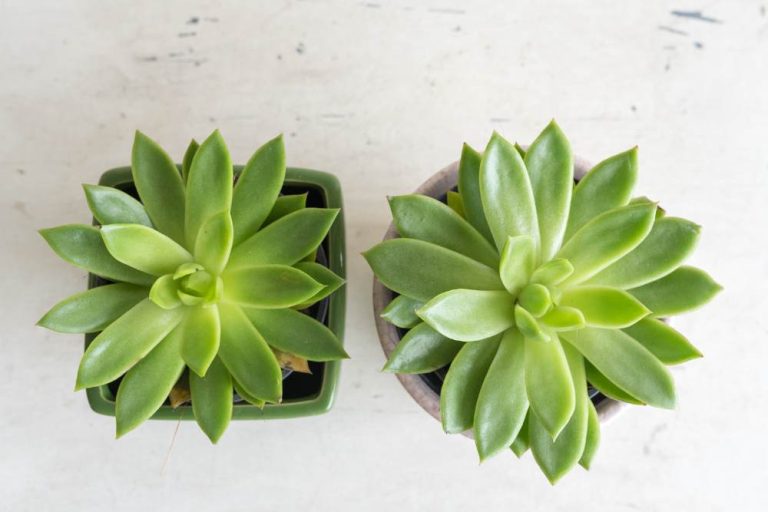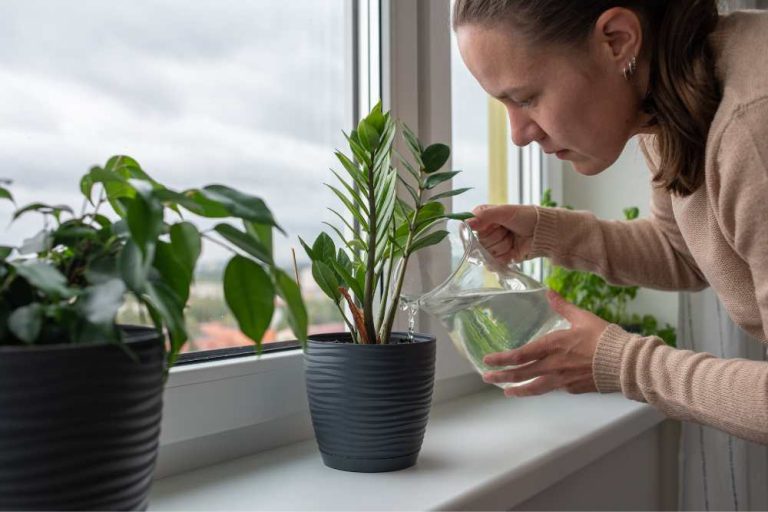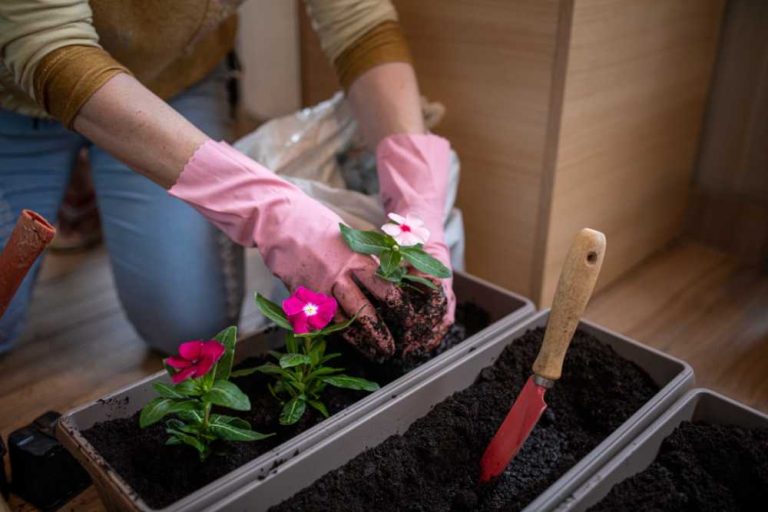10 Top Picks Best Plants for Open Terrarium
Are you looking to create an indoor garden that adds a touch of green to your space without requiring constant care and attention? Look no further than open terrariums! These mini ecosystems are not only visually appealing but also incredibly low-maintenance. But which plants are the best fit for open terrariums?
In this article, we will explore the top picks for open terrarium plants that can thrive in the unique conditions of these glass enclosures. Whether you’re a beginner or a seasoned terrarium gardener, these plant recommendations will help you create a thriving open terrarium that adds life and beauty to your home or office.
Key Takeaways:
Understanding Open Terrariums
Before we explore the best plants for open terrariums, let’s take a moment to understand what sets them apart from other types of terrariums. Open terrariums, as the name suggests, have an open or partially open top, allowing for better air circulation and minimizing moisture buildup. This key difference affects the ideal conditions and plant selection for your open terrarium.
An open terrarium requires plants that can tolerate slightly drier conditions compared to closed or semi-closed terrariums. It’s essential to choose plants that thrive in moderate to bright indirect light and can handle a slightly lower humidity level. By understanding these distinctions, you can effectively create a flourishing open terrarium.
Factors to Consider When Choosing Plants
When it comes to selecting the best plants for your open terrarium, there are several important factors to consider. By choosing plants that thrive in high humidity, low light conditions, and require minimal care, you can ensure the success and longevity of your indoor terrarium.
High Humidity
One of the key considerations for open terrarium plants is their ability to tolerate high humidity levels. Open terrariums allow for better airflow and ventilation compared to closed or semi-closed terrariums, but they still maintain a relatively humid environment. Look for plants that naturally thrive in humid conditions, such as ferns, mosses, and tropical plants.
Low Light Conditions
Most open terrariums are located indoors, away from direct sunlight. Therefore, it’s essential to choose plants that can thrive in low light conditions. Opt for shade-tolerant species, such as pothos, snake plants, and ZZ plants, which can adapt well to the limited light intensity found indoors.
Minimal Care Requirements
When selecting plants for your open terrarium, consider their care requirements. Choosing low-maintenance plants not only simplifies your gardening routine but also ensures the long-term health of your terrarium. Look for plants that are known for their resilience and ability to withstand occasional neglect, such as succulents, air plants, and certain types of cacti.
Read – How to Make Your Own Terrarium in 8 Easy Steps
Succulents for Open Terrariums
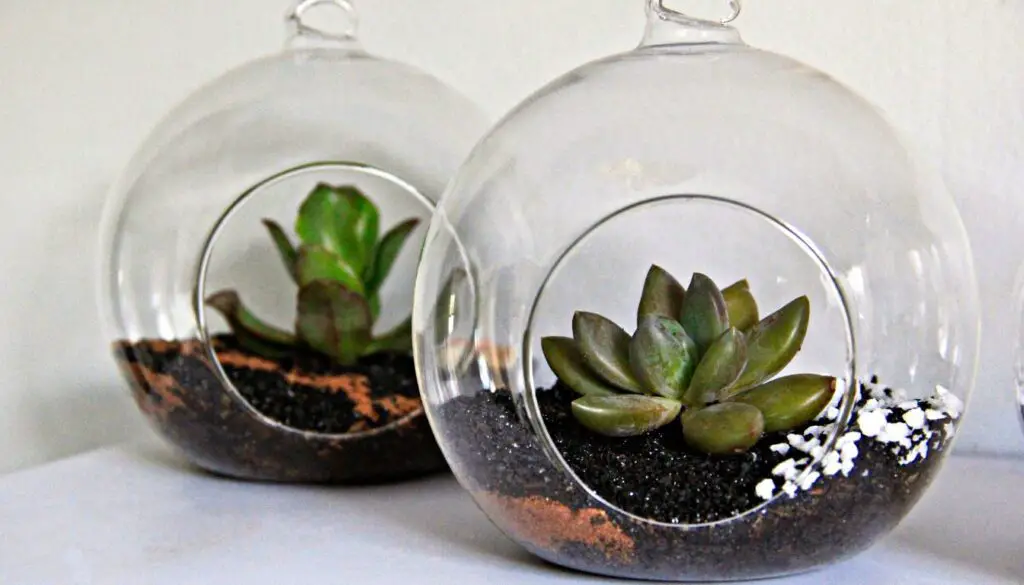
Succulents are best terrarium plants that are highly popular choices for open terrariums. Their unique ability to thrive in arid conditions makes them ideal for creating a low-maintenance terrarium. These plants have thick, fleshy leaves that store water, allowing them to withstand long periods of drought.
When selecting succulents for your open terrarium, consider their growth habit and size. Some succulent varieties grow tall and upright, while others have a trailing or rosette-like form. This diversity allows you to create a visually appealing terrarium with different textures and shapes.
Here are a few best succulent varieties that can add a touch of uniqueness to your open terrarium:
Haworthia:
Haworthia is a genus of small succulent plants that are perfect for open terrariums. These plants have striking, architectural leaves that come in various patterns, from smooth and stripy to spiky and textured. Haworthias are low-maintenance plants that thrive in bright but indirect light.
Echeveria:
Echeverias are stunning rosette-shaped succulents known for their captivating colors and compact size. From vibrant green to shades of pink, purple, and even blue, echeverias add a pop of color to your open terrarium. These plants require ample sunlight and infrequent watering, making them suitable for low-maintenance terrariums.
Sedum:
Sedums, also known as stonecrops, are versatile succulents that come in various shapes and sizes. Some sedum varieties have a trailing habit, while others form small, clumping rosettes. These plants are incredibly hardy and can withstand neglect with ease, making them perfect for beginners and busy plant lovers.
With their low-maintenance nature and ability to thrive in arid conditions, succulents are excellent choices for open terrariums. Their unique forms, colors, and textures will undoubtedly add a touch of beauty to your indoor garden.
Ferns for Open Terrariums
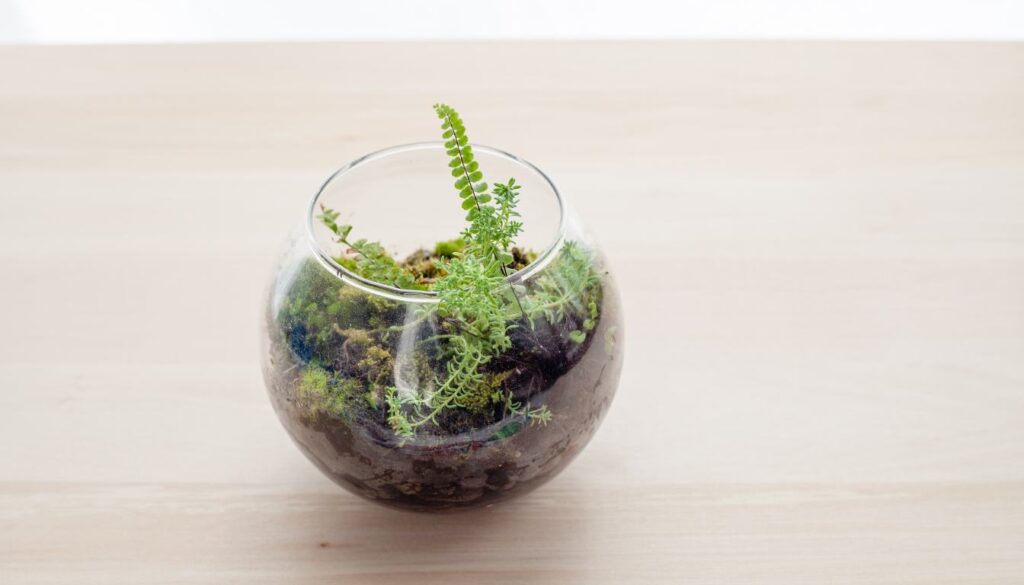
When it comes to selecting the best terrarium plants for your indoor oasis, ferns are a top choice. These elegant green beauties thrive in the moist, humid environments of open terrariums, making them the perfect addition to your collection. Not only do ferns bring lush green foliage, but they also add a touch of elegance to your open terrarium.
Different Fern Species for Your Open Terrarium
There are several fern species that are well-suited for open terrariums. Here are a few popular choices:
1. Boston Fern (Nephrolepis exaltata):
Known for its arching fronds and delicate appearance, the Boston Fern is a classic choice for open terrariums. Its feathery foliage creates a beautiful visual impact and adds a sense of tranquility to your indoor garden.
2. Maidenhair Fern (Adiantum raddianum):
With its delicate and lacy fronds, the Maidenhair Fern adds a touch of elegance to any open terrarium. This fern thrives in high-humidity environments and brings a unique texture to your terrarium display.
3. Staghorn Fern (Platycerium spp.):
The Staghorn Fern is known for its distinctive antler-like fronds, which give it its name. This epiphytic fern can be mounted on a wooden plank or hung in your open terrarium, showcasing its fascinating growth habit.
4. Bird’s Nest Fern (Asplenium nidus):
The Bird’s Nest Fern is known for its wide, crinkled leaves that resemble a bird’s nest. This fern can add a pop of green and create a focal point in your open terrarium, creating a mini tropical paradise.
Read – Beauty Of Boston Fern Species
Caring for Ferns in Your Open Terrarium
To ensure your ferns thrive in your open terrarium, it’s important to provide them with the right care:
1. Light:
Ferns prefer bright, indirect light. Place your open terrarium in a location where it can receive filtered light, away from direct sunlight to prevent leaf burn.
2. Water:
Keep the soil consistently moist but not waterlogged. Mist the foliage of your ferns regularly to maintain the high humidity levels they require.
3. Humidity:
Ferns thrive in humid environments, so make sure to monitor humidity levels in your open terrarium. You can increase humidity by placing a tray of water near your terrarium or using a humidifier.
Moss and Moss-like Plants for Open Terrariums
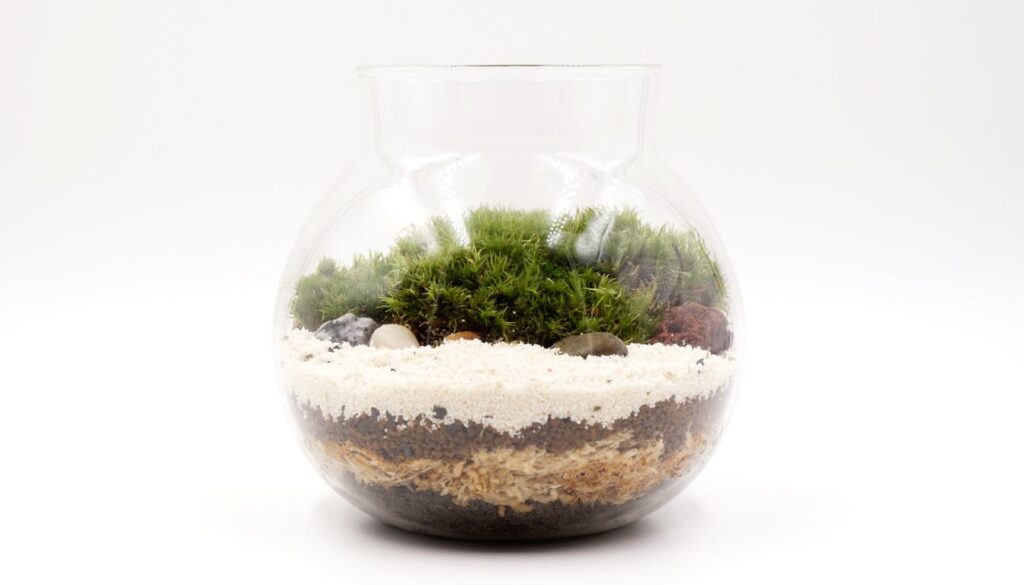
Incorporating moss and moss-like plants in your open terrarium can bring a lush and vibrant touch to your indoor garden. These plants create a carpet of green, adding a natural and soothing element to your terrarium landscape.
There are a variety of moss and moss-like plants that are ideal for open terrariums and require minimal care. Let’s explore some popular choices:
Sphagnum Moss
Sphagnum moss is a great option for open terrariums due to its ability to retain moisture and provide a humid environment for other terrarium plants. Its soft and fluffy texture adds visual interest and creates a cozy ambiance.
Sheet Moss
Sheet moss, also known as hypnum moss, is a low-growing moss with dense, carpet-like foliage. It thrives in moist and shaded conditions, making it a perfect fit for open terrariums. Sheet moss can create a plush green carpet effect and enhance the overall aesthetic appeal.
Cushion Moss
Cushion moss, as the name suggests, forms compact and cushion-like structures, adding texture and depth to your open terrarium. It has a velvety appearance and can tolerate both bright and low light conditions.
Club Moss
Club moss, or Selaginella, is a moss-like plant that brings a unique touch to your open terrarium. It features delicate, feathery foliage that can range in color from vibrant green to bronze or red. Club moss prefers high humidity and indirect light, making it a suitable choice for open terrariums.
Air Plants for Open Terrariums
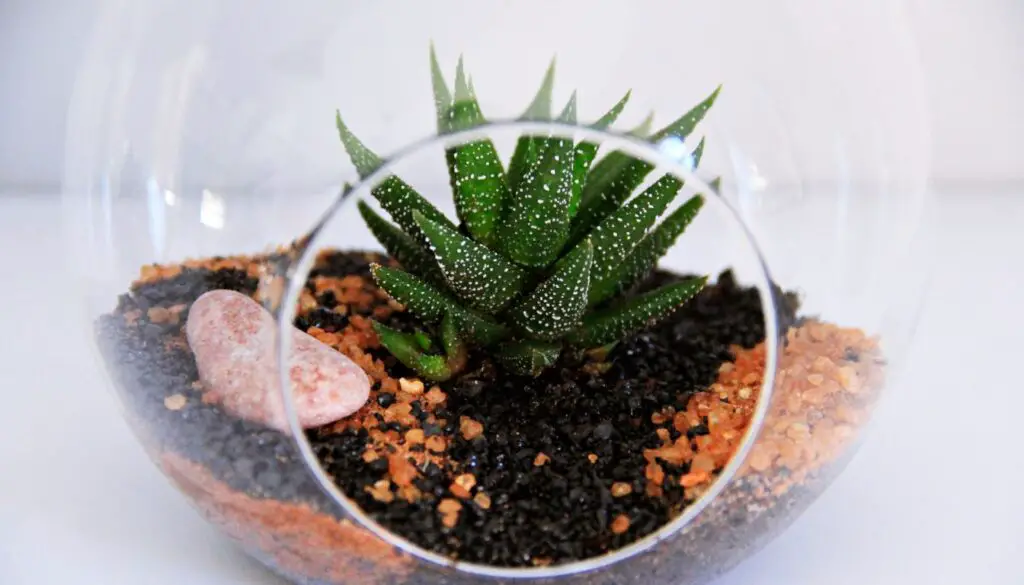
Air plants, also known as tillandsias, are a unique and captivating choice for your open terrarium. These fascinating plants do not require soil to grow, making them low-maintenance options that can add a touch of charm to your indoor space.
Displaying Air Plants in Your Open Terrarium
One of the beauties of air plants is their versatility in terms of display. Since they don’t require soil, you can get creative with how you showcase them in your open terrarium.
Here are a few ideas to inspire you:
- Hanging Terrariums: Use a transparent container with an open top and hang it from the ceiling or a wall-mounted hook.
- Decorative Containers: Find unique vessels like seashells or glass orbs to hold your air plants and create an eye-catching centerpiece.
- Miniature Gardens: Combine air plants with other terrarium plants, rocks, or miniature figurines to create a whimsical, miniature garden within your open terrarium.
Caring for Air Plants in Your Open Terrarium
While air plants are relatively low-maintenance, they still require proper care to ensure their health and longevity.
Here are some essential care tips for your air plants:
- Light: Place your open terrarium in a location with bright, indirect light. Air plants thrive in filtered sunlight.
- Watering: Mist your air plants with water or give them a thorough soak in room temperature water once or twice a week. Make sure to shake off excess water to prevent rot.
- Air Circulation: Air plants need good airflow to prevent moisture buildup. Avoid placing them in a closed container.
- Fertilizing: Although not necessary, you can use a diluted air plant fertilizer once a month to provide additional nutrients.
By following these care guidelines, you can enjoy the beauty and unique charm of air plants in your open terrarium. Remember to regularly inspect your air plants for signs of stress or drying out, and make any necessary adjustments to their care routine.
Vining Plants for Open Terrariums
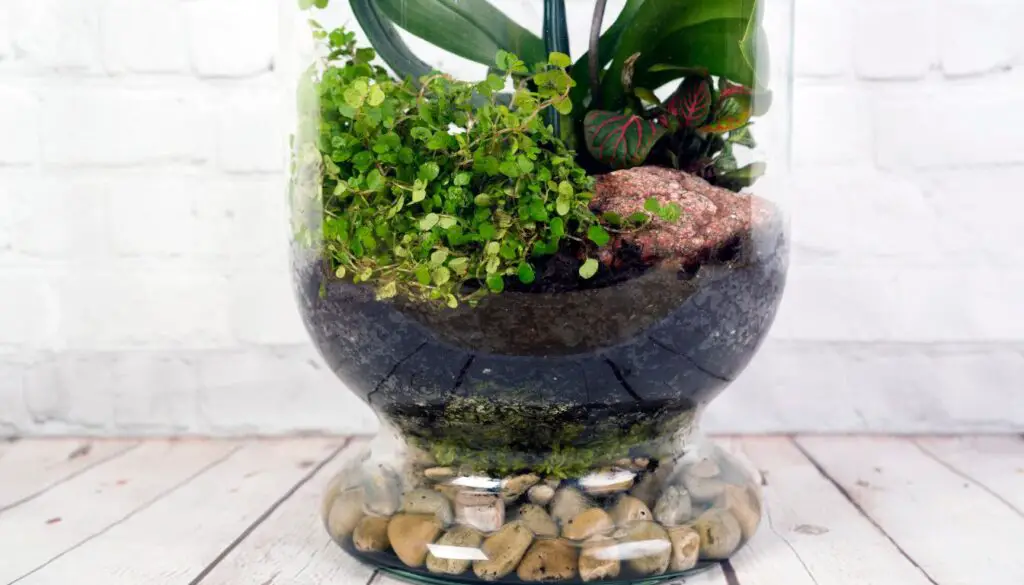
Vining plants are a fantastic choice for your open terrarium as they can create a stunning cascading effect, adding a touch of beauty and elegance to your indoor garden. These plants are not only visually appealing but also low-maintenance, making them a popular choice for terrarium enthusiasts.
When selecting vining plants for your open terrarium, there are a few popular choices that you can consider:
Pothos
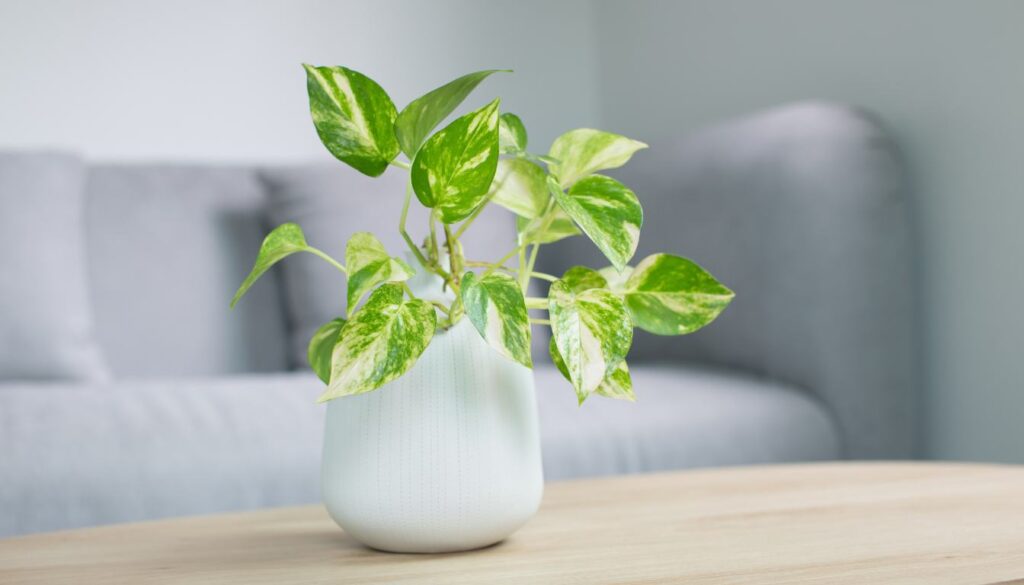
Pothos, also known as devil’s ivy, is a versatile and hardy vining plant that is perfect for open terrariums. With its heart-shaped leaves and trailing vines, pothos adds a touch of lushness to any terrarium.
String of Pearls
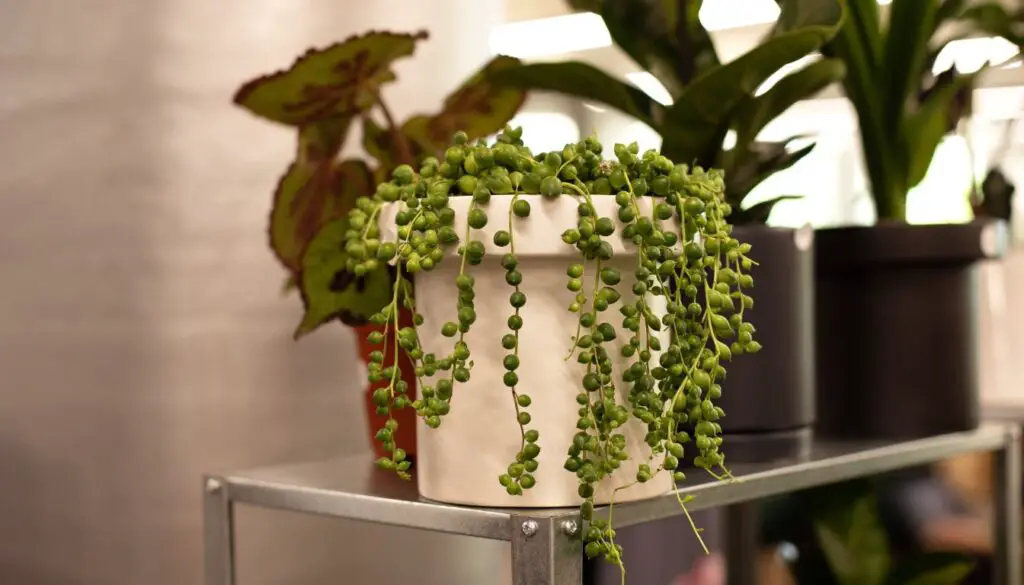
String of Pearls, or Senecio rowleyanus, is a unique and eye-catching vining plant that features small, bead-like leaves cascading down from thin stems. Its delicate appearance and vibrant green color make it a popular choice for adding texture and interest to open terrariums.
English Ivy
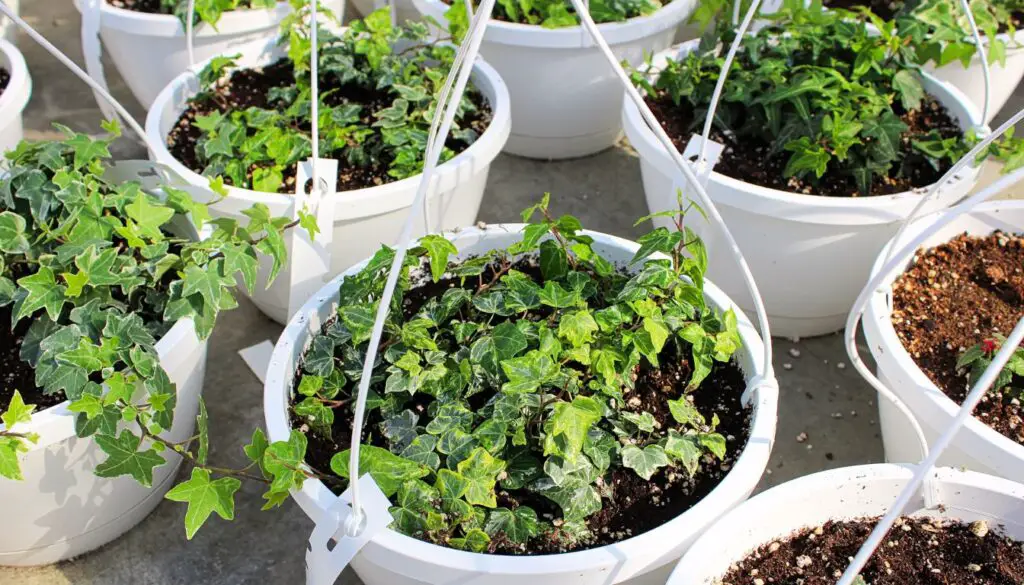
English Ivy, scientifically known as Hedera helix, is a classic and timeless vining plant that can thrive in the high humidity of open terrariums. Its evergreen foliage and ability to grow rapidly make it an excellent choice for creating a lush and green terrarium landscape.
These vining plants are well-suited for the open terrarium environment, thriving in low light conditions and requiring minimal care. Remember to provide them with adequate water and occasional pruning to maintain their growth and shape. With these popular vining plant choices, you can create a breathtaking open terrarium that will be the envy of any indoor gardening enthusiast.
Orchids for Open Terrariums
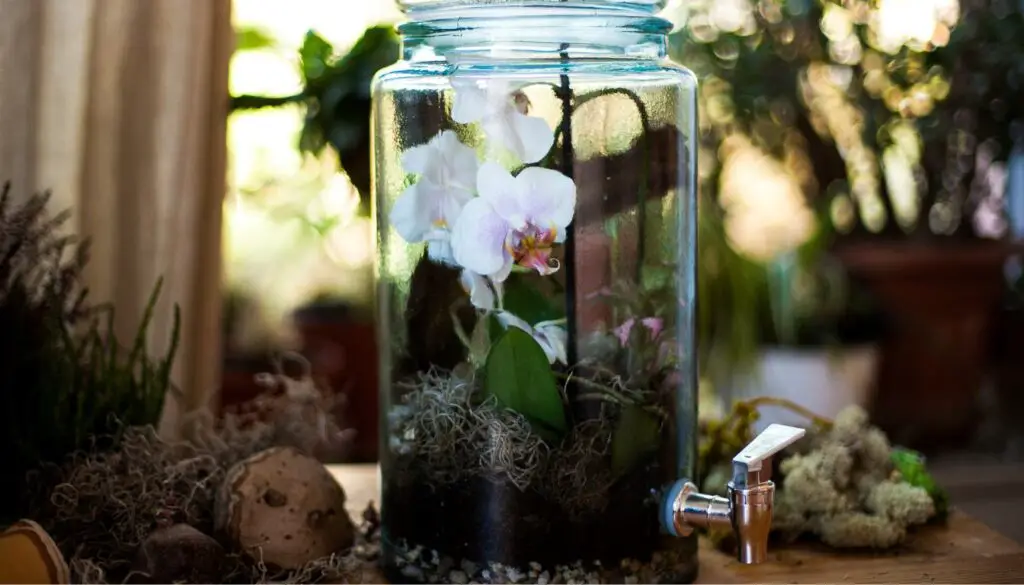
Orchids are the epitome of elegance and can bring a touch of sophistication to your open terrarium. These exquisite plants thrive in the humid conditions that open terrariums provide. When selecting orchids for your terrarium, it’s essential to choose varieties that are well-suited to this environment and require minimal care.
Popular Orchid Varieties for Open Terrariums
When it comes to orchid choices for your open terrarium, there are a few varieties that stand out. Phalaenopsis orchids, also known as moth orchids, are a popular choice due to their beautiful flowers and adaptability to indoor conditions. Other suitable orchids include Paphiopedilum orchids, also known as lady’s slipper orchids, and Dendrobium orchids.
Phalaenopsis orchids feature stunning blooms in vibrant colors, such as white, pink, and purple. Lady’s slipper orchids have unique and intricate flowers, while Dendrobium orchids display clusters of blooms along their tall stems.
Care Tips for Orchids in Open Terrariums
To ensure the health and longevity of your orchids in an open terrarium, follow these care tips:
1. Light: Orchids require bright, indirect light. Place your terrarium in a location where it will receive filtered sunlight or artificial light.
2. Humidity: Orchids thrive in high humidity, similar to the conditions found in open terrariums. Mist the leaves and roots regularly to create a humid environment.
3. Temperature: Most orchids prefer temperatures between 60°F (15°C) and 80°F (27°C). Avoid placing your terrarium in areas with temperature fluctuations or drafts.
4. Watering: Orchids should be watered when the potting medium feels dry but not completely dried out. Avoid overwatering, as this can lead to root rot.
5. Fertilization: Feed your orchids with a balanced orchid fertilizer according to the manufacturer’s instructions. Fertilize during the active growth period, typically in spring and summer.
Cacti and Succulent Companions for Open Terrariums
Enhance the beauty and diversity of your open terrarium by incorporating cacti and other succulent companions. These low-maintenance terrarium plants not only add visual appeal to your indoor garden but also create a harmonious environment alongside your succulents.
When choosing cacti and succulent companions, opt for species that are popular among terrarium enthusiasts and require minimal care. Some popular terrarium plants to consider include:
– Echeveria elegans: With its stunning rosette shape and gray-green leaves, this succulent adds elegance and charm to your open terrarium.
– Haworthia fasciata: Commonly known as the “Zebra Plant,” this succulent features unique striped leaves that create a striking contrast in your terrarium.
– Aloe vera: A versatile and well-known succulent with soothing properties, the aloe vera plant brings both beauty and functionality to your open terrarium.
– Coryphantha ramillosa: This small and compact cactus adds a touch of color to your terrarium with its vibrant yellow flowers.
Creating a Balanced Display
When arranging your cacti and succulent companions, consider creating a balanced display by varying the heights and shapes of the plants. This encourages visual interest and allows each plant to thrive without overcrowding. Additionally, you can incorporate decorative rocks or sand to mimic their natural desert habitat and enhance the aesthetic appeal of your terrarium.
Remember to take into account the specific care requirements of each plant. While cacti and succulents are known for their low-maintenance nature, it’s important to provide adequate lighting, well-draining soil, and occasional watering to ensure their optimal growth and health.
With the addition of cacti and succulent companions, your open terrarium can become a captivating display of desert-inspired beauty. Experiment with different combinations and create a unique landscape that brings joy and tranquility to your indoor space.
Maintenance Tips for Open Terrarium Plants
Proper maintenance is crucial to ensure the long-term health and vitality of your open terrarium plants. By following these essential tips on watering, pruning, and addressing common issues, you can create an environment where your plants will thrive.
1. Watering:
When it comes to watering your open terrarium plants, it’s important to strike the right balance. Unlike closed terrariums, which require limited watering, open terrariums allow for greater airflow and evaporation. Regularly check the moisture level of the soil and only water when it feels dry to the touch. Avoid overwatering, as it can lead to rot and fungal growth.
2. Pruning:
Regular pruning is essential to maintain the health and appearance of your open terrarium plants. Remove any dead or discolored leaves, as they can attract pests and hinder healthy growth. Trim back overgrown branches to maintain the desired size and shape of your plants.
3. Lighting:
While open terrariums allow for more light penetration compared to closed terrariums, it’s important to provide the right amount of light for your plants. Most terrarium plants thrive in bright, indirect light. Place your open terrarium in a location that receives filtered or dappled sunlight, away from direct sunlight that can scorch the delicate leaves.
4. Common Issues:
Even with proper care, open terrarium plants can encounter a few common issues. Keep an eye out for signs of pests such as aphids or spider mites. If pests are present, treat them with organic insecticidal soap or neem oil. Additionally, be mindful of excessive heat or cold drafts, which can stress or damage your plants. Maintaining a stable room temperature is key to their well-being.
FAQ
What are the best plants for an open terrarium?
Some of the best plants for open terrariums include succulents, ferns, moss, air plants, vining plants, and orchids. These plants are well-suited to the high humidity and low light conditions typically found in open terrariums.
What makes an open terrarium different from other types of terrariums?
Unlike closed or semi-closed terrariums, open terrariums have no lid or covering, allowing for more air circulation. This makes open terrariums better suited for plants that thrive in slightly drier conditions and prefer indirect light.
What factors should I consider when choosing plants for my open terrarium?
When selecting plants for your open terrarium, consider their preferences for high humidity, low light conditions, and low-maintenance requirements. It’s important to choose plants that can thrive in the specific environment provided by an open terrarium.
Can I use succulents in an open terrarium?
Yes, succulents are excellent choices for open terrariums. They can thrive in arid conditions and require minimal watering. Some popular succulents for open terrariums include echeverias, haworthias, and jade plants.
Are ferns suitable for open terrariums?
Yes, ferns are well-suited for open terrariums due to their love for humid environments. Boston ferns, maidenhair ferns, and bird’s nest ferns are among the popular choices for adding lush green foliage to your open terrarium.
What are some good options for moss and moss-like plants in an open terrarium?
Moss and moss-like plants are ideal for creating a carpet of vibrant green in your open terrarium. Some popular choices include sheet moss, fern moss, and mood moss. These plants require minimal care and can thrive in a humid environment.
How can I incorporate air plants into my open terrarium?
Air plants, or tillandsias, can be attached to driftwood, stones, or other decorative elements within your open terrarium. They don’t require soil and can obtain nutrients and moisture from the air. Mist or soak them occasionally to keep them healthy.
Can I use vining plants in my open terrarium?
Yes, vining plants can add a beautiful cascading effect to your open terrarium. Some popular choices include pothos, ivy, and string of hearts. These plants can thrive in the high humidity and low light conditions of an open terrarium.
Can I include orchids in my open terrarium?
Yes, certain orchid varieties can thrive in the humid conditions of an open terrarium. Epiphytic orchids, such as Phalaenopsis and Oncidium, are popular choices. Ensure they receive adequate air circulation and provide them with the right amount of light and humidity.
Can I mix cacti with succulents in an open terrarium?
Yes, combining cacti with other succulent companions can create a visually appealing and diverse open terrarium. Choose small varieties of cacti, such as Echeveria or Mammillaria, and ensure they receive enough sunlight and well-draining soil.
How do I maintain plants in an open terrarium?
Proper maintenance is crucial for the health of your open terrarium plants. Water them sparingly, ensuring the soil is slightly moist but not waterlogged. Prune any dead or yellowing leaves and address any pests or diseases promptly. Monitor the light conditions and adjust as necessary.
- 20+ Chic Boho Bedroom Ideas for a Cozy and Stylish Retreat - June 20, 2024
- 12+ Modern Boho Living Room Ideas to Create a Unique Oasis - June 10, 2024
- 10 Stunning Canopy Bed Ideas for a Dreamy Escape - May 16, 2024

